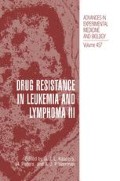Abstract
Induction of apoptosis by daunorubicin (DNR) and idarubicin (IDA) was evaluated cytofluorometrically in CEM and CEM-MDR1+ leukemic cells exposed to drug concentrations similar to peak plasma levels obtainable in vivo (DNR 200–400 ng/ml, IDA 50–100 ng/ml, 30′ incubation), and differentiating apoptosis from necrosis (FITC-annexin V+/propidium iodide- and + cells, respectively). Firstly, to set experimental conditions, apoptosis was evaluated in CEM cells at 3, 6, 12, 18, 24, 48, 72, and 96 hours from end of drug incubation, the maximal increase being noted at 24–48 hours. Net apoptosis rates were determined after subtraction of the spontaneous activity observed in untreated cells. The apoptotic effect from varying drug type and concentration was compared at 24 hours in CEM-MDR1+ cells, with and without co-incubation with MDR1 functional downregulator cyclosporin A (CSA) used at therapeutic concentration (1500 ng/ml). The results indicated that, at drug concentrations likely to be approached in vivo as a short-lasting peak level (IDA 100–200 ng/ml) with increased-dose IDA (>12–15 mg/m2), pro-apoptotic effects by IDA+CSA in CEM-MDR1+ cells were significantly greater than by DNR+CSA, and corresponded to the levels observed with IDA 50 ng/ml without CSA in control CEM cells. This in vitro study demonstrates that it is possible to determine in the same sample cell fluorescence related to anthracyclines, apoptotic cells (FITC-annexin V positive), and necrotic cells (propidium iodide positive), and confirms that cytofluorimetric evaluation of apoptosis can reliably predict the effects of anthracycines in function of drug type, concentration and, in MDR1+ cells, concurrent MDR1 inhibition. Extension of this assay to the clinical ground may be warranted.
Access this chapter
Tax calculation will be finalised at checkout
Purchases are for personal use only
Preview
Unable to display preview. Download preview PDF.
References
Hannun YA. Apoptosis and the dilemma of cancer chemotherapy. Blood 89:1845–1853, 1997.
Speth PAJ, Minderman H, Haanen C: Idarubicin v daunorubicin: preclinical and clinical pharmacokinetic studies. Semin Oncol 16:2–9, 1989 (suppl 2).
Ames MA, Spreafico F: Selected pharmacologic characteristics of idarubicin and idarubicinol. Leukemia 6:70–75, 1992 (suppl 1).
Wheatley K: Meta-analysis of randomized trials of idarubicin (IDAR) or mitozantrone (MITO) versus daunorubicin (DNR) as induction therapy for acute myeloid leukemia (AML). Blood 86: 434a, 1995 (suppl 1, abstr).
Bassan R, Barbui T: Remission induction therapy for adults with acute myelogenous leukemia: towards the ICE age?. Haematologica 80:82–90, 1995.
Ross D, Tong Y, Cornblatt B: Idarubicin (IDA) is less vulnerable to transport-mediated multidrug resistance (MDR) than its metabolite idarubicinol (IDAol) or daunorubicin (DNR). Blood 82: 257a, 1993 (suppl 1, abstr 1015).
Berman E, McBride M: Comparative cellular pharmacology of daunorubicin and idarubicin in human multidrug-resistant leukemia cells. Blood 79:3267–3273, 1992.
Chiodini B, Bassan R, Borleri G, Lerede T, Barbui T. Idarubicin activity against multidrug resistant (mdr-1+) cells is increased by cyclosporin A. In: Hiddemann W et al (eds.) Acute Leukemias VII. Springer, Berlin 1998, pp. 475–482.
Leith CP, Chen I-M, Kopecky KJ, et al: Correlation of multidrug resistance (MDR1) protein expression with functional dye/drug efflux in acute myeloid leukemia by multiparameter flow cytometry: identification of discordant MDR-/efflux+ and MDR+/efflux- cases. Blood 86:2329–2342, 1995.
Reid JM, Pendergrass TW, Krailo MD, Hammond GD, Ames MM: Plasma pharmacokinetics and cerebrospinal fluid concentrations of idarubicin and idarubicinol in pediatric leukemia patients. A Childrens Cancer Study Group report. Cancer Res 50:6525–6528, 1990.
List AF, Speier C, Greer J, et al: Phase I/II trial of cyclosporine as a chemotherapy-resistance modifier in acute leukemia. J Clin Oncol 11:1652–1660, 1993.
Koopman G, Reutelingsperger CPM, Kuijten GAM, et al: Annexin V for flow cytometric detection of phosphatidylserine expression on B cells undergoing apoptosis. Blood 84:1415–1420, 1994.
Kokenberg E, Sonneveld P, Delwel R, et al: In vivo uptake of daunorubicin by acute myeloid leukemia (AML) cells measured by flow cytometry. Leukemia 2:511–517, 1988.
List AF: The role of multidrug resistance and its pharmacological modulation in acute myeloid leukemia. Leukemia 10: S46–S51, 1996 (suppl 2).
Solary E, Caillot D, Chauffert B, et al: Feasibility of using quinine, a potential multidrug resistance-reversing agent, in combination with mitoxantrone and cytarabine for the treatment of acute leukemia. J Clin Oncol 10:1730–1736, 1992.
Kornblau SM, Estey E, Madden T, et al: Phase I study of mitoxantrone plus etoposide with multidrug blockade by SDZ PSC-833 in relapsed or refractory acute myelogenous leukemia. J Clin Oncol 15:1796–1802, 1997.
Ito C, Ribeiro RC, Behm FG, Raimondi SC, Pui C-H, Campana C. Cyclosporin A induces apoptosis in childhood acute lymphoblastic leukemia cells. Blood 91:1001–1007, 1998.
Ross DD, Wooten PJ, Tong Y, et al: Synergistic reversal of multidrug-resistance phenotype in acute myeloid leukemia by cyclosporin A and cremophor EL. Blood 83:1337–1347, 1994.
Weiss M, Maslak P, Megherian L, Scheinberg D. A phase I trial of a single high dose of idarubicin combined with high dose cytarabine (ARA-C) as induction therapy in relapsed and refractory adult patients with acute lymphoblastic leukemia (ALL). Blood 86: 786a, 1995 (suppl 1, abstr 3131).
Author information
Authors and Affiliations
Editor information
Editors and Affiliations
Rights and permissions
Copyright information
© 1999 Springer Science+Business Media New York
About this chapter
Cite this chapter
Chiodini, B., Bassan, R., Barbui, T. (1999). Apoptosis by Anthracyclines at Therapeutic Concentrations in MDR1+ Human Leukemic Cells. In: Kaspers, G.J.L., Pieters, R., Veerman, A.J.P. (eds) Drug Resistance in Leukemia and Lymphoma III. Advances in Experimental Medicine and Biology, vol 457. Springer, Boston, MA. https://doi.org/10.1007/978-1-4615-4811-9_34
Download citation
DOI: https://doi.org/10.1007/978-1-4615-4811-9_34
Publisher Name: Springer, Boston, MA
Print ISBN: 978-1-4613-7180-9
Online ISBN: 978-1-4615-4811-9
eBook Packages: Springer Book Archive

